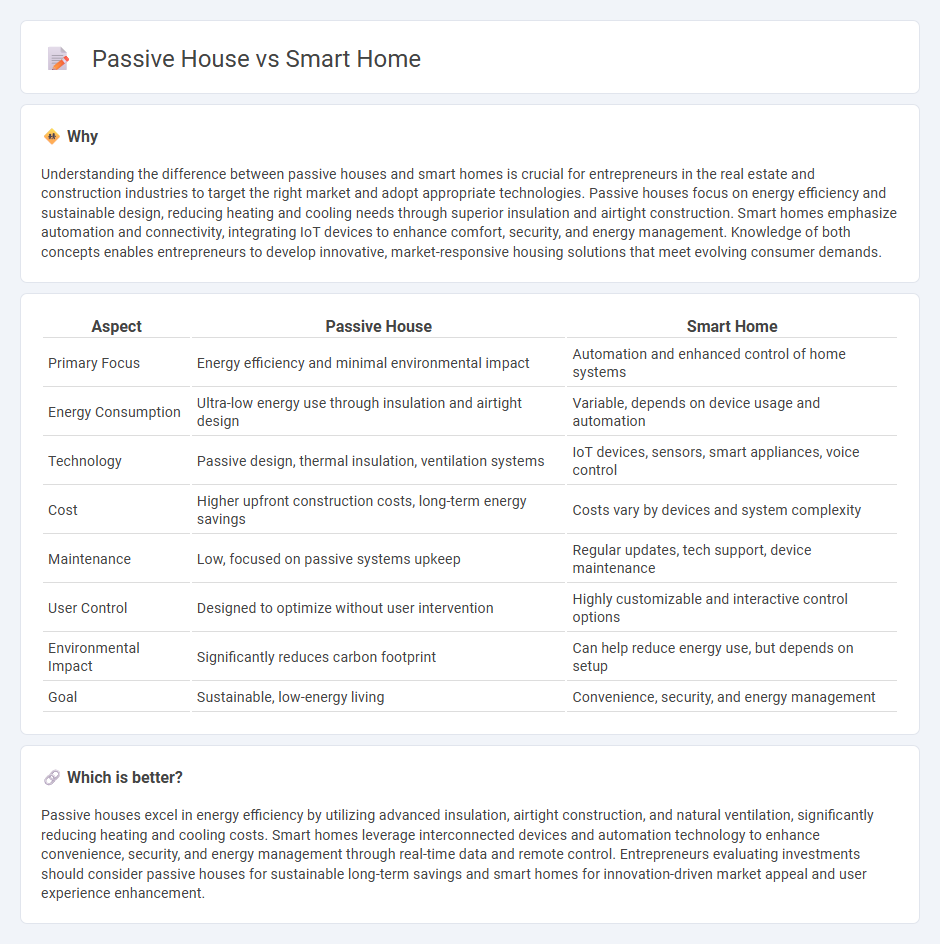
Entrepreneurship in the housing sector is rapidly evolving with innovations like Passive Houses and Smart Homes driving sustainability and technology integration. Passive Houses focus on energy efficiency and minimal environmental impact through superior insulation and airtight construction, while Smart Homes emphasize automation and connectivity for enhanced convenience and security. Explore how these two trends can revolutionize modern living and create new business opportunities.
Why it is important
Understanding the difference between passive houses and smart homes is crucial for entrepreneurs in the real estate and construction industries to target the right market and adopt appropriate technologies. Passive houses focus on energy efficiency and sustainable design, reducing heating and cooling needs through superior insulation and airtight construction. Smart homes emphasize automation and connectivity, integrating IoT devices to enhance comfort, security, and energy management. Knowledge of both concepts enables entrepreneurs to develop innovative, market-responsive housing solutions that meet evolving consumer demands.
Comparison Table
| Aspect | Passive House | Smart Home |
|---|---|---|
| Primary Focus | Energy efficiency and minimal environmental impact | Automation and enhanced control of home systems |
| Energy Consumption | Ultra-low energy use through insulation and airtight design | Variable, depends on device usage and automation |
| Technology | Passive design, thermal insulation, ventilation systems | IoT devices, sensors, smart appliances, voice control |
| Cost | Higher upfront construction costs, long-term energy savings | Costs vary by devices and system complexity |
| Maintenance | Low, focused on passive systems upkeep | Regular updates, tech support, device maintenance |
| User Control | Designed to optimize without user intervention | Highly customizable and interactive control options |
| Environmental Impact | Significantly reduces carbon footprint | Can help reduce energy use, but depends on setup |
| Goal | Sustainable, low-energy living | Convenience, security, and energy management |
Which is better?
Passive houses excel in energy efficiency by utilizing advanced insulation, airtight construction, and natural ventilation, significantly reducing heating and cooling costs. Smart homes leverage interconnected devices and automation technology to enhance convenience, security, and energy management through real-time data and remote control. Entrepreneurs evaluating investments should consider passive houses for sustainable long-term savings and smart homes for innovation-driven market appeal and user experience enhancement.
Connection
Entrepreneurship in sustainable building technologies bridges Passive House principles and Smart Home innovations by integrating energy-efficient design with advanced automation systems. Passive Houses minimize energy consumption through high-performance insulation and airtight construction, while Smart Homes enhance comfort and efficiency using intelligent control of lighting, heating, and appliances. This convergence creates market opportunities for entrepreneurs developing eco-friendly, technologically advanced living spaces that reduce environmental impact and operational costs.
Key Terms
Automation Technology
Smart homes integrate advanced automation technology to control lighting, climate, security, and appliances, enhancing energy efficiency and user convenience. Passive houses prioritize airtight construction, high insulation, and natural ventilation to reduce energy consumption without relying heavily on automated systems. Explore the latest automation technologies in smart homes to understand their impact on sustainable living.
Energy Efficiency
Smart homes integrate advanced automation systems to optimize energy consumption by controlling lighting, heating, and appliances in real-time, resulting in significant electricity savings. Passive houses achieve energy efficiency through superior insulation, airtight construction, and heat recovery ventilation, drastically reducing heating and cooling demands. Explore the comparative benefits of smart home technology and passive house design to enhance your property's sustainability.
Market Differentiation
Smart homes incorporate advanced automation systems optimizing energy efficiency, security, and convenience, targeting tech-savvy consumers seeking customizable living environments. Passive houses rely on rigorous building standards and superior insulation to achieve minimal energy consumption, appealing to environmentally conscious buyers prioritizing sustainability and long-term savings. Explore detailed comparisons to understand which housing innovation aligns best with your market and lifestyle preferences.
Source and External Links
What is a Smart Home? Everything You Need to Know - TechTarget - A smart home is a residence equipped with internet-connected devices that enable remote monitoring and management of appliances and systems such as lighting, heating, and security, often controlled via a smart home hub like Amazon Echo or Google Home.
What is a smart home and what are the benefits? - Constellation - A smart home system connects and automates tasks through appliances to enhance energy efficiency, convenience, and control, offering benefits such as energy savings and remote management of home functions like sprinklers, security, and HVAC.
Manage Your Smart Home With Google Home | Google Home - The Google Home app allows users to control and automate their smart home devices remotely, customize device management, and review smart camera activity for increased convenience, security, and energy savings.
 dowidth.com
dowidth.com